
Deposition Date
2019-07-21
Release Date
2019-11-06
Last Version Date
2024-10-30
Method Details:
Experimental Method:
Resolution:
1.49 Å
R-Value Free:
0.23
R-Value Work:
0.20
R-Value Observed:
0.20
Space Group:
C 1 2 1


